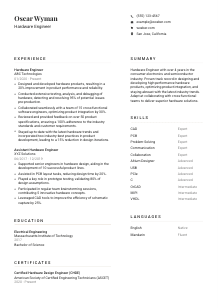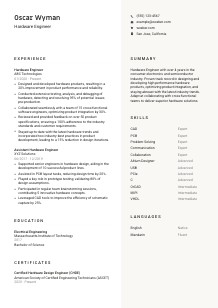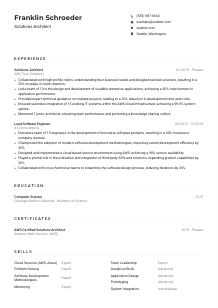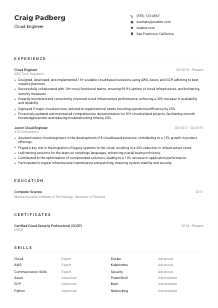Hardware Engineer Resume Example
Designing circuit boards but feeling short-circuited by your resume? Dive into this Hardware Engineer resume example, developed with Wozber free resume builder. See how seamlessly you can wire your technical genius to meet job voltages, resonating your expertise with the power and precision employers seek!
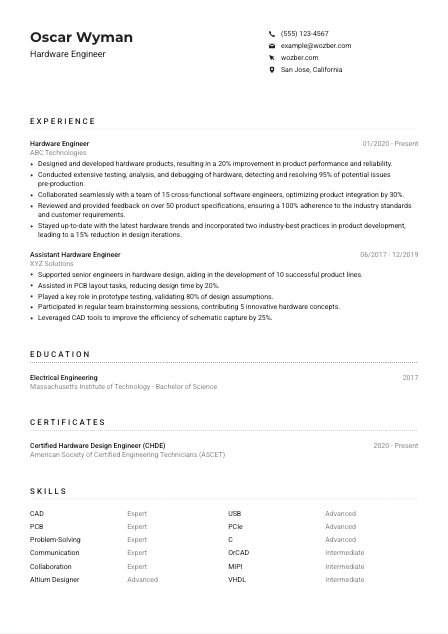
How to write a Hardware Engineer Resume?
Hey there, future Hardware Engineer marvel! Ready to transform your resume into a high-performance blueprint that captures not just the attention but also the admiration of hiring managers? Let's embark on this electrifying journey together, wielding the power of Wozber's free resume builder. Picture your resume as your personal circuit board, where each component – from personal details to your professional summary – is optimized to resonate with your dream job's frequency. Buckle up, and let's engineer your success story.
Personal Details
First impressions last, and in the case of your resume, the Personal Details section is where this impression begins. Let's illuminate how to make this section shine brighter than a freshly soldered PCB for your Hardware Engineer position.
1. Branding with Your Name
Think of your name as the power button on a device — it needs to be prominent and functional. Make sure it's the first thing that catches the eye, akin to a well-placed LED indicator, by using a clear, standout font.
2. Matching the Job Title
Mimic the precision of aligning components on a circuit board by slotting in the job title just below your name. This acts as a clear signal to the ATS and hiring manager that you are calibrated for the role of a 'Hardware Engineer.'
3. Ensuring Connectivity with Contact Information
Your phone number and email address are your communication protocols, make them error-free. Stick with an email that follows the firstname.lastname@domain.com blueprint, ensuring it's as professional and clean as a well-drafted schematic.
4. Matching the Geographic Circuit
When a job specifies a location like San Jose, California, including this in your contact details instantly connects with the employer's requirements, affirming that you're within range for optimal collaboration.
5. Hyperlinking to Your Professional Portfolio
Just as a datasheet provides deeper insight into a component's capabilities, a LinkedIn profile or personal website can offer a more comprehensive view of your professional universe. Make it a clickable link for easy access.
Takeaway
Your Personal Details are the I/O ports of your resume, providing essential interfaces for potential employers to connect with you. By crafting this section with care, you're setting up a strong handshake protocol that appeals to both human and automated reviewers.





Experience
The Experience section is where your technical proficiency and project successes come alive. Let's ensure each bullet point is as meticulously engineered as a custom PCB, demonstrating your unique contributions and achievements.
- Designed and developed hardware products, resulting in a 20% improvement in product performance and reliability.
- Conducted extensive testing, analysis, and debugging of hardware, detecting and resolving 95% of potential issues pre‑production.
- Collaborated seamlessly with a team of 15 cross‑functional software engineers, optimizing product integration by 30%.
- Reviewed and provided feedback on over 50 product specifications, ensuring a 100% adherence to the industry standards and customer requirements.
- Stayed up‑to‑date with the latest hardware trends and incorporated two industry‑best practices in product development, leading to a 15% reduction in design iterations.
- Supported senior engineers in hardware design, aiding in the development of 10 successful product lines.
- Assisted in PCB layout tasks, reducing design time by 20%.
- Played a key role in prototype testing, validating 80% of design assumptions.
- Participated in regular team brainstorming sessions, contributing 5 innovative hardware concepts.
- Leveraged CAD tools to improve the efficiency of schematic capture by 25%.
1. Decoding the Blueprint
Start by dissecting the job description like you would a complex circuit diagram. Identify the key elements that align with your own experience, such as 'hardware design and testing' or 'CAD tools expertise.'
2. Arranging Components Chronologically
Arrange your professional landmarks in reverse chronological order, ensuring that your latest, most relevant projects are easiest to access, much like prioritizing components in a circuit for efficiency.
3. Highlighting Achievements with Precision
For each role, articulate your accomplishments with the precision of a finely tuned oscilloscope. Phrases like 'Designed and developed hardware products, resulting in a 20% improvement in product performance and reliability' illustrate your impact vividly.
4. Quantifying Results
Numbers speak louder than words in any engineering field. Where possible, quantify your successes – whether it's performance improvements, cost reductions, or efficiency gains – to give tangible proof of your engineering prowess.
5. Filtering Out the Noise
Maintain focus on experiences directly relevant to the Hardware Engineer role. Extraneous information can clutter your resume's signal, diluting the impact of your most pertinent accomplishments.
Takeaway
Think of your Experience section as the core processor of your resume, highlighting your operational efficiency and capacity for innovation. Each bullet point should add to the narrative that you're the ideal candidate for the role. Tailor each line to reflect the job description, making your resume as compatible with the role as a well-integrated circuit.
Education
While your Education section might seem as fundamental as a resistor on a board, it's crucial to the overall circuitry of your resume. Let's program this section to showcase your academic achievements in a way that resonates with the role's requirements.
1. Aligning with Educational Protocols
Highlight the degree most relevant to the position, such as 'Bachelor of Science in Electrical Engineering.' This aligns with the 'hardware design' core of the job description and positions you as a candidate with the necessary foundational knowledge.
2. Structuring with Clarity
Maintain a clear and concise layout: Degree title, followed by the institution and graduation date. This straightforward structure ensures that key details are as easy to locate as components on a well-designed board.
3. Optimizing Degree Details
If your degree directly matches the job requirements, make sure it's front and center. For instance, spotlight your 'Bachelor of Science in Electrical Engineering,' which precisely fits the role's educational criteria.
4. Highlighting Relevant Courses and Achievements
This is like detailing the specifications of a component on a PCB — useful for understanding its role in the larger system. If you've taken specialized courses or completed projects that are directly relevant, make sure they are highlighted.
5. Including High-Value Extras
Similar to how special features on a chip can make it more valuable, distinguishing achievements like honors or relevant extracurriculars can enhance your educational section, demonstrating your passion and initiative.
Takeaway
Your Education section is the foundation upon which your professional skills are built. By clearly showcasing degrees and qualifications that align with the Hardware Engineer role, you're demonstrating to employers that you have the academic grounding to back up your practical skills. It's about making your educational journey resonate with the path you're aiming to follow in your career.
Certificates
In the ever-evolving field of hardware engineering, certifications act like firmware updates, enhancing your resume's capabilities. Let's explore how to list your certifications to showcase your continuous improvement and relevance in the industry.
1. Identifying Relevant Updates
Start by pinpointing certifications that directly enhance your qualifications for the Hardware Engineer role. If you've attained a 'Certified Hardware Design Engineer (CHDE)' recognition, it directly signals your commitment to excellence in your field.
2. Highlighting Necessary Certifications
List certifications that directly speak to the job requirements or elevate your proficiency in key skills. Quality trumps quantity; focus on those that are most impactful.
3. Adding Dates to Show Currency
Much like ensuring your software is up to date, including the acquisition or expiration dates of your certifications shows that your skills are current and relevant.
4. Keeping Your Certifications Up-to-Date
Just as hardware technologies evolve, so should your certifications. Regularly seeking out new certifications can demonstrate your commitment to staying at the forefront of your field.
Takeaway
Your certification section is a testament to your dedication to professional growth and proficiency in the latest technological advancements. Highlighting relevant, up-to-date certifications can significantly enhance your resume, much like a firmware upgrade that unlocks new functionalities in hardware.
Skills
In the realm of hardware engineering, your Skills section is akin to the technical specifications of a product – it showcases the capabilities that make you a valuable asset. Let's optimize this section to reflect the high-performance skills demanded by your target role.
1. Extracting Relevant Skills
Begin by mining the job description for key skills like 'CAD expertise' or 'knowledge of digital and analog circuit design.' These are the technical competencies you want to foreground in your resume, as they directly address the employer's needs.
2. Emphasizing Pertinent Abilities
Tailor your skills list to mirror the job requirements, focusing on both hard skills like 'PCB layout design' and soft skills such as 'excellent problem-solving.' This balance showcases your all-around capability as a Hardware Engineer.
3. Maintaining Clarity and Focus
Avoid overwhelming this section with every skill you possess. Like choosing the right components for a circuit to avoid noise, select skills that align closely with the job description for the most impact.
Takeaway
Your skills section is your chance to showcase your technical competence and professional versatility. By precisely tailoring this part of your resume to mirror the job description, you signal to both ATS systems and human reviewers that you're a high-fidelity match for the position.
Languages
In a global market, the ability to communicate across language barriers can be as crucial as interfacing different components on a PCB. Your language skills can significantly broaden the horizons of your employability, especially in multinational companies.
1. Assessing the Communication Protocol
For the Hardware Engineer role, being 'comfortable communicating in English' is a baseline requirement. Position your English language proficiency at the forefront of your languages section, followed by any additional languages you speak fluently.
2. Prioritizing Key Languages
Single out especially relevant languages for the role or industry. While the job may specify English, other languages can be beneficial, enhancing your role as a liaison in international teams or projects.
3. Detailing Your Fluency Levels
Use clear, standardized descriptions to quantify your proficiency levels. Similar to specifying a component's tolerances, this helps employers understand exactly how you can communicate in different languages.
4. Embracing the Diversity of Your Skill Set
Even if not directly related to the job requirements, supplementary languages you speak can add depth to your resume, indicating a versatile and adaptable candidate.
5. Understanding the Broader Context
For roles that might involve interaction with international clients or teams, emphasizing your linguistic capabilities can set you apart as a candidate who's ready for the challenges of a global marketplace.
Takeaway
Your proficiency in multiple languages is a testament to your ability to navigate diverse settings and collaborate across cultures. Like the universal protocols that enable different devices to communicate, your language skills can be a profound asset, marking you as a versatile and capable Hardware Engineer in a globalized industry.
Summary
The Professional Summary segment of your resume is the initial handshake – a brief yet powerful introduction that conveys your qualifications and enthusiasm for the role. Let's calibrate this section to engage and captivate the hiring manager's attention right from the start.
1. Capturing the Essence of Your Career
Delve into the core of the job description, integrating key phrases like ‘designing and developing high-performance hardware products.' This aligns your summary with the specific responsibilities and skills sought after by employers.
2. Beginning with a Strong Introduction
Begin with a statement that encapsulates your professional identity and dedication to the field of hardware engineering. This is your chance to highlight your overarching commitment and passion for the discipline.
3. Reflecting the Job's Key Requirements
Echo the job's primary requirements, such as 'excellent problem-solving and communication skills' and 'expertise in digital and analog circuit design.' This indicates you're not just a contender for the role but a natural fit.
4. Keeping It Concise and Impactful
Condense your narrative to pack a punch within a few lines. Just like optimizing a circuit for maximum efficiency, your summary should distill your professional essence into a brief yet potent introduction.
Takeaway
Your Professional Summary is your resume's elevator pitch. Tailoring it to signify your alignment with the Hardware Engineer role ensures you immediately catch the attention of hiring managers. Make every word count, and let this section amplify your suitability and zeal for the position, setting the stage for a deep dive into your technical skills and professional milestones.
Launching Your Hardware Engineer Journey
Congratulations, you've just completed an important step towards landing your dream Hardware Engineer role! Armed with these tailored strategies and Wozber's accompanying tools, including the free resume builder and ATS-friendly resume templates, you're now equipped to craft a resume that not only meets but exceeds the expectations of any hiring manager. Remember, your resume is more than a document; it's a reflection of your professional journey and aspirations. Use your insights, skills, and Wozber's resources to forge a path to your next big opportunity.
The future is bright, and it awaits your unique contributions. Best of luck!

- Bachelor's degree in Electrical Engineering, Computer Engineering, or a related field.
- Minimum of 3 years of experience in hardware design and testing, preferably in the consumer electronics or semiconductor industry.
- Expertise in using CAD tools such as Altium Designer or OrCAD for schematic capture and PCB layout.
- Strong knowledge of digital and analog circuit design, including high-speed interfaces (e.g., USB, PCIe, MIPI).
- Excellent problem-solving, communication, and collaboration skills.
- The candidate should be comfortable communicating in English.
- Must be located in San Jose, California.
- Design and develop hardware products, including schematics, PCB layouts, and prototypes.
- Conduct testing, analysis, and debugging of hardware to ensure performance and reliability.
- Collaborate closely with cross-functional teams, including software engineers, to optimize product integration.
- Review and provide feedback on product specifications, ensuring adherence to industry standards and customer requirements.
- Keep updated with the latest hardware trends, tools, and technologies to incorporate the best practices in product development.





